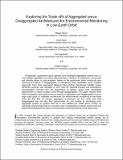| dc.contributor.author | Dwyer, Morgan | |
| dc.contributor.author | Selva, Daniel | |
| dc.contributor.author | Szajnfarber, Zoe | |
| dc.contributor.author | Del Portillo Barrios, Inigo | |
| dc.contributor.author | Sanchez Net, Marc | |
| dc.contributor.author | Cameron, Bruce Gregory | |
| dc.contributor.author | Crawley, Edward F. | |
| dc.date.accessioned | 2015-05-07T13:52:08Z | |
| dc.date.available | 2015-05-07T13:52:08Z | |
| dc.date.issued | 2014-08 | |
| dc.identifier.isbn | 978-1-62410-257-8 | |
| dc.identifier.uri | http://hdl.handle.net/1721.1/96925 | |
| dc.description.abstract | Traditionally, government space agencies have developed aggregated systems that co-host multiple capabilities on shared spacecraft buses. However, in response to cost growth and schedule delays on past programs, leaders in the government space community have expressed an interest in disaggregation, or distributing their capabilities across multiple spacecraft. Since their aggregated National Polar-orbiting Operational Satellite System (NPOESS) program was cancelled in 2010, both the National Oceanic and Atmospheric Administration (NOAA) and the Department of Defense (DoD) have investigated opportunities to reduce program costs through disaggregation. This paper expands their initial investigation and explores the cost impacts of aggregation and disaggregation across a large trade space of candidate architectures for environmental monitoring in low-Earth orbit. We find that on average, aggregated architectures are less costly than fully disaggregated ones but also find opportunities for cost savings by developing semi-aggregated systems, or systems with one or two satellites per orbital plane. Finally, we investigate several trades that are currently under consideration by NOAA and the DoD and make recommendations for future environmental monitoring systems in low-Earth orbit. | en_US |
| dc.description.sponsorship | Massachusetts Institute of Technology (Sandia Corporation Excellence in Engineering Graduate Fellowship) | en_US |
| dc.description.sponsorship | Skolkovo Institute of Science and Technology | en_US |
| dc.language.iso | en_US | |
| dc.publisher | American Institute of Aeronautics and Astronautics | en_US |
| dc.relation.isversionof | http://dx.doi.org/10.2514/6.2014-4416 | en_US |
| dc.rights | Creative Commons Attribution-Noncommercial-Share Alike | en_US |
| dc.rights.uri | http://creativecommons.org/licenses/by-nc-sa/4.0/ | en_US |
| dc.source | MIT web domain | en_US |
| dc.title | Exploring the Trade-offs of Aggregated versus Disaggregated Architectures for Environmental Monitoring in Low-Earth Orbit | en_US |
| dc.type | Article | en_US |
| dc.identifier.citation | Dwyer, Morgan, Daniel Selva, Inigo del Portillo, Marc Sanchez-Net, Bruce Cameron, Zoe Szajnfarber, and Edward Crawley. “Exploring the Trade-Offs of Aggregated Versus Disaggregated Architectures for Environmental Monitoring in Low-Earth Orbit.” AIAA SPACE 2014 Conference and Exposition (August 2014). | en_US |
| dc.contributor.department | Massachusetts Institute of Technology. Department of Aeronautics and Astronautics | en_US |
| dc.contributor.department | Massachusetts Institute of Technology. Engineering Systems Division | en_US |
| dc.contributor.mitauthor | Dwyer, Morgan | en_US |
| dc.contributor.mitauthor | Del Portillo Barrios, Inigo | en_US |
| dc.contributor.mitauthor | Sanchez Net, Marc | en_US |
| dc.contributor.mitauthor | Cameron, Bruce Gregory | en_US |
| dc.contributor.mitauthor | Crawley, Edward F. | en_US |
| dc.relation.journal | Proceedings of the AIAA SPACE 2014 Conference and Exposition | en_US |
| dc.eprint.version | Author's final manuscript | en_US |
| dc.type.uri | http://purl.org/eprint/type/ConferencePaper | en_US |
| eprint.status | http://purl.org/eprint/status/NonPeerReviewed | en_US |
| dspace.orderedauthors | Dwyer, Morgan; Selva, Daniel; del Portillo, Inigo; Sanchez-Net, Marc; Cameron, Bruce; Szajnfarber, Zoe; Crawley, Edward | en_US |
| dc.identifier.orcid | https://orcid.org/0000-0001-8230-5155 | |
| dc.identifier.orcid | https://orcid.org/0000-0001-9438-9712 | |
| mit.license | OPEN_ACCESS_POLICY | en_US |
| mit.metadata.status | Complete | |
